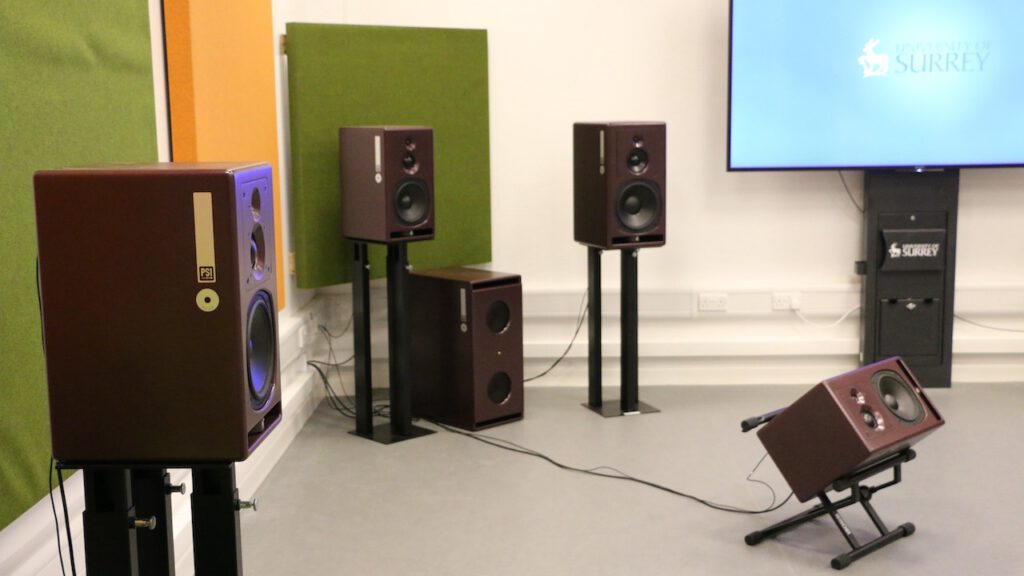The University of Surrey has installed a large immersive audio setup of 23 PSI Audio speakers in a new multi-purpose listening room. 17 A23-M, two A25-M and four Sub A225-M constitute an elaborate system that can be adjusted to accommodate a number of different formats, from ring of eight, quad and stereo to 5.x and 7.x to object-based formats like Dolby Atmos. The university for excellence in media creation and the pinnacle of Swiss precision sound – a match made in Surrey.
University of Surrey: excellence in media creation
When it comes to formal education in the field of media creation, the UK has a fairly comprehensive range of different schools and universities. The University of Surrey, however, enjoys the highest renown among them, its graduates regularly winning awards and working at the top of the industry. The unique blend of musical study, electronic music performance, audio engineering and sound-recording practice prepares the students for pretty much any job in the industry, from music production to broadcasting to research and development. All around the department’s hallways, there are posters that compile some of the graduates’ achievements – which tends to become a problem sometimes, as Senior Lecturer Alan Haigh explains: “Every time I show a graduate around, they go: I have got an award. Why am I not up there? So we need a lot more of them, or maybe take them down.”
Immersive sound for the creators of tomorrow
The impressive facilities encompass multiple high-end recording studios as well as actual broadcasting studios. In accordance with current developments, immersive audio plays a significant role as well. “We have one NHK-like room for research,” Alan Haigh elucidates. “There is a research project that uses the 22.2 setup to explore how you can generate immersive audio with all sorts of different speakers. Say you have a stereo system and other devices like phones, tablets or Bluetooth speakers in the room – can you connect them and make them create appropriate audio? That kind of research is going on there.” Dr Tom Hall adds: “We also have a Dolby Atmos room planned with a 9.4.4 setup.” And then there is the recently equipped room, of course – the one with the PSI Audio speakers.
PSI Audio delivers immaculate accuracy
The new Creative Music Technology Studio features a total of 23 PSI Audio speakers: a ring of eight A23-M on ear level, four A23-M as floor speakers, four A23-M as ceiling speakers, one A23-M as central ceiling speaker (“Voice of God”), two A25-M for the left and right channels and four Sub A225-M subwoofers. A setup of that size can be a challenge to handle, as Tom Hall confirms: “I spent most of my time with channel mappings. That is a lot of work, especially if you are switching between different configurations.” More important than the number of loudspeakers is their quality and coherence, especially if you want to recreate an authentic and seamless immersive experience. With their dynamic and natural transients, their linearity in frequency and phase and their sonic coherence across models, PSI Audio speakers excel in this field. And it shows: Tom Hall, Alan Haigh and Senior Lecturer Dr Russell Mason are very happy with the sound, its transparent and detailed reproduction of complex audio. The result is a room for a number of applications: it is a compositional space for immersive music; a small performance space; and, of course, a teaching space with a serious monitoring setup. Tom Hall is very happy with the result: “It’s just lovely to be in here. The students all love it. I really look forward to exploring the sonic possibilities of this new space.”
PSI Audio and Surrey University: a work in progress
An ambitious project like this is never quite finished, though, and so there are plans to further elaborate on the potential of the studio. Some more acoustic treatment is in the works. Different stands for the floor speakers to optimize their angle are also on the cards. “And a rug wouldn’t go amiss,” Tom Hall says with a smile. But despite the possibility for further improvement, the professors are enthusiastic about the sound, and how little digital correction it required. “We did a little EQ,” Alan Haigh explains. “I haven’t touched the top end, just a few little bass things, very minimal.” Apart from the sound, the 100 percent analogue design of the PSI Audio speakers appealed to Tom Hall. “There’s a trend to replace analogue circuitry with digital tech. But analogue, you know – it’s just what it is and doesn’t try to be anything else. That was attractive to me.”





